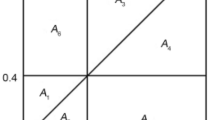Abstract
Public healthcare plans are essential to regions present around the world and deriving optimal strategies to combat the negative effects is one of the tasks involved in the process. Measuring similarity between two regions based on a common attribute is a popular problem, and this paper aims to find a method for the same, the common attribute being a key statistic taken from public health surveillance records. The method uses the application of rough measurement concept to determine the similarity between different regions having disease-linked death rates, which in turn can effectively be used to derive contingency plans in the case of a relevant event or before the next one takes place. We also take advantage of GIS tools to help in the processing and visualization of spatial data, and this paper discusses the role of GIS in public health surveillance as well.
Access this chapter
Tax calculation will be finalised at checkout
Purchases are for personal use only
Similar content being viewed by others
References
Pawlak, Z.: Rough sets. Int. J. Comput. Inform. Sci. 11(5), 341–356 (1982)
Boulos, M.N.K.: Towards evidence-based, GIS-driven national spatial health information infrastructure and surveillance services in the United Kingdom. Int. J. Health Geogr. 3(1) (2004)
Liao, W.: The rough method for spatial data subzone similarity measurement. J. Geogr. Inf. Syst. 4(01) (2012)
Gunaratna, N., Liu, Y., Park, J.: Spatial autocorrelation. J. Recuperado el 2 (2013)
Scotch, M., et al.: Exploring the role of GIS during community health assessment problem solving: experiences of public health professionals. Int. J. Health Geogr. 5(1) (2006)
Sharmila Banu, K., Tripathy, B.K.: Data analytics in spatial epidemiology: a survey. J. Technol. 78(10), 159–165 (2016)
Quantum Geographic Information System (software). https://www.qgis.org/
Centers for Disease Control and Prevention. https://www.cdc.gov/
Lenarčič, A.: Rough sets, similarity and optimal approximations. Ph.D. thesis, McMaster University, June (2017)
Braun-Blanquet, J: Pflanzensoziologie. Springer (1928)
Author information
Authors and Affiliations
Corresponding author
Editor information
Editors and Affiliations
Rights and permissions
Copyright information
© 2020 Springer Nature Singapore Pte Ltd.
About this paper
Cite this paper
Jain, P., Varday, H., Sharmila Banu, K., Tripathy, B.K. (2020). Enhancing Public Health Surveillance by Measurement of Similarity Using Rough Sets and GIS. In: Das, K., Bansal, J., Deep, K., Nagar, A., Pathipooranam, P., Naidu, R. (eds) Soft Computing for Problem Solving. Advances in Intelligent Systems and Computing, vol 1048. Springer, Singapore. https://doi.org/10.1007/978-981-15-0035-0_21
Download citation
DOI: https://doi.org/10.1007/978-981-15-0035-0_21
Published:
Publisher Name: Springer, Singapore
Print ISBN: 978-981-15-0034-3
Online ISBN: 978-981-15-0035-0
eBook Packages: Intelligent Technologies and RoboticsIntelligent Technologies and Robotics (R0)




